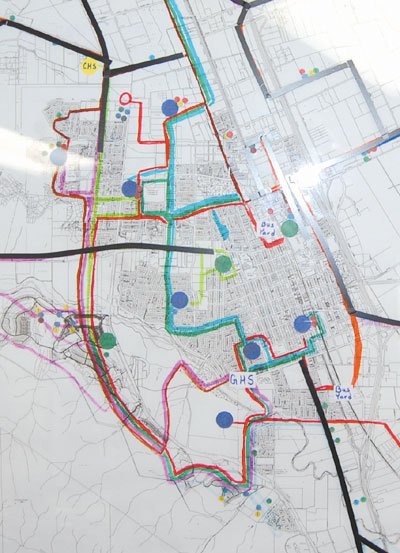With classes kicking off in three days, the Gilroy Unified
School District’s busing situation is a
”
glass-half full, glass-half empty scenario.
”
With classes kicking off in three days, the Gilroy Unified School District’s busing situation is a “glass-half full, glass-half empty scenario.”
On one hand, GUSD has cut six of its 12 bus routes, $225,000 from its transportation budget and will now cater to 540 of the 1,100 students it served last year. The district also dissolved positions for five drivers, one dispatcher and one instructor.
The district downsized its transportation department the last two years without impacting passengers, but GUSD Transportation Supervisor Annie Sharp underlines the newest round of reductions “is the one that hurts.”
On the other hand, “GUSD is one of the few districts in the county to still have home-to-school transportation even available,” she points out. “Many districts already eliminated home-to-school transportation altogether.”
During a 2010-11 school year emblazoned with lively protests against reducing elementary music and physical education, increasing class sizes and cutting salaries across-the-board; transportation services took a significant hit. Although Sharp observes “we’re always on the back burner” when it comes to the public spotlight.
For more than half of the Gilroy students accustomed to riding the yellow bus to school, however, imminent changes are on the agenda.
A total of 30 home-to-school stops have been eliminated, affecting 96 students residing in the Eagle Ridge community off Santa Teresa Boulevard. Stops for students living along Princevalle Street and Sunrise Park have been eliminated. Transportation to GoKids, a nonprofit child development services with two locations in Gilroy, the Dr. T.J. Owens Gilroy Early College Academy – an alternative high school known as GECA located on the Gavilan College campus – as well as after-school tutoring, will cease. Shuttles ferrying athletes in-between high schools and middle schools are also kaput.
In re-designing their routes, Sharp says staff did their best to accommodate as many students living the farthest away from their neighborhood school site as possible.
“We are a ways out here for most,” said GECA Principal Mary Ann Boylan. “That said, we get students from as far as Los Banos, Salinas, Hollister, Watsonville, South San Jose and they make it. So, with the state of the State, it is what it is, unfortunately.”
Sharp says transportation cuts were made in an effort to reduce a $400,000 encroachment on GUSD’s $81.5 million general fund, but points out Gilroy is faring better than most. Transportation departments all over California have been struggling for years, she says.
“I feel fortunate that we are able to provide any level of service, considering the circumstances and the budget situation in the state of California,” Sharp said.
The Morgan Hill Unified School District, for example, has been charging parents for transportation for 16 years, according to MHUSD Deputy Superintendent Bonnie Tognazzini. The cost for one student to ride the bus annually is $310, with rates dipping if the student qualifies for free and reduced lunch. In the Hollister Unified School District, “we currently do not charge, but we’re looking at it, come middle the school year,” says HUSD Transportation Coordinator Alicia Parra. For high school students, HUSD has been charging $1 per trip for awhile, she says.
The Aromas-San Juan Unified School District has been charging high school students for transportation for the last three years, according to Bridget Garnett, the district’s purchasing/accounts payable payroll technician. Bus passes cost $354 annually; $154 for the first semester and $200 for the slightly longer second semester. Students can also opt for a bus card punch pass, which goes up in $40 increments.
GUSD hasn’t finalized its transportation data for the 2010-11 school year. Kirsten Perez, director of Fiscal Services for GUSD, says the cost of regular home-to-school transportation for the 2009-10 school year was $1,550 per student. That’s on top of federally required transportation for Special Education, which costs $5,030 per student.
While GUSD found ways to restructure its services, “after three years of reductions, we simply cannot serve all of the students now as we have done in the past,” wrote Sharp in a letter recently sent to all GUSD parents.
Since then, “the phone has been ringing off the hook,” she said. “But to everyone’s credit, they’ve been really kind.”
What some people may not know, Sharp adds, is that California does not legally require districts to provide home-to-school transportation for its students. Couple this with a dubious forecast in education funding – GUSD is bracing for a possible $3 million in mid-year “trigger cuts” – Sharp says an estimated 70 percent of state districts will eliminate daily busing services by 2012.
“That’s amazing,” she ogles. “It would be different if the need wasn’t there. But the need hasn’t gone away.”
Adding to that anxiety?
The wild card of funding ambiguity.
If state revenues come in under projected amounts, Sharp says transportation funding could be slashed even deeper by January next year.
But if you take a cue from her, outlook is a matter of attitude.
Despite seeing her support staff dwindle from five to three, in addition to dealing with five bus drivers who quit last year upon learning they were going to be laid off, Sharp maintains a dogged devotion to her vocation. In 1986 she made a career crossover from biotechnology to busing for the sake of trying something new. She’s never regretted the decision.
“I start crying at board meetings when I tell people how good my drivers are,” she said, tearing up.
At 5:30 p.m. on a Wednesday afternoon, Sharp sat surrounded by a daunting mountain range of paperwork she admitted would likely keep her there until 9 p.m. The GUSD Transportation Supervisor of 18 months drives a two-hour commute, five days from her home in Paso Robles to GUSD’s transportation headquarters on 8067 Swanston Lane off Leavesley Avenue.
“Morale is good,” she said, of her staff. “They’ve been professional and consistent, despite worrying about their jobs. They put that to the side when they get on the bus and drive the kids.”
School’s in session
– Classes begin Monday, Aug. 22 for all schools in Gilroy Unified School District
– To read an update letter from GUSD Superintendent Debbie Flores, visit the GUSD website at www.gusd.k12.ca.us.
– To reach GUSD administrative offices, call 847-2700.
School zone safety
– The Gilroy Police Department has secured federal grant funding for a “Safe Routes to School” program. GPD will deploy extra officers to conduct saturated traffic enforcement at schools at specified times during the school year.
– GPD Sgt. Chad Gallacinao issued a community reminder: “Child and school safety is everyone’s responsibility. The department encourages motorists and pedestrians to be cautious, patient and responsible. Parents are encouraged to develop pick-up/drop- off plans with their children that are safe, abide by school safety rules and do not violate traffic laws.”
– GPD will crack down on these vehicle code violations in school zones: Double parking, illegal U-turns, speed impeding traffic (stopping in the traffic lane) and pedestrian violations that include jaywalking, cell phone violations and distracted driving violations.
Bus need-to-know
– To view bus route schedules, visit the GUSD’s website at www.gusd.k12.ca.us. Scroll down midway, then click on the “transportation routes” link. Click on any of the schools listed to view different lists of routes.
– All afternoon bus drop-off times are one hour earlier on Wednesdays.
– Students will not be allowed to ride the bus from any location other than the bus stop that is in conjunction with their home address. Parents should expect a bus registration form to be sent home the first week of school, which needs to be completed and returned as soon as possible.
– Direct questions to GUSD Transportation Supervisor Annie Sharp at 842-6614.
Tdap booster required
– Under a new California law that took effect July 1, 2011, all California middle and high school students must be vaccinated against pertussis, or whooping cough, for this upcoming 2011-2012 school year.
– California legislation recently passed Senate Bill 614 on July 14, which grants local educational agencies an extra 30 days after classes begin to verify whooping cough vaccinations of all 7th-through-12th grade students in California.
– Several pharmacies and clinics offer the Tdap shot (including at a low-cost if you don’t have insurance): Gardner South County Health Center: 7526 Monterey St. Call: (408) 846-6755. Cost is $15 for qualified low-cost applicants; School Health Clinic of Santa Clara County, Gilroy neighborhood health clinic: 7861 Murray Ave. Call: (408) 842-1017. Cost is $15 for qualified low-cost applicants; Walgreens: 770 First St. Call: (408) 847-0983. Cost is $63.99 without insurance; Rite Aid: 360 E.10th St. Call: (408) 848-2328. Cost is $57.99 without insurance














